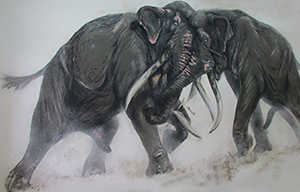Ο «χαμένος παράδεισος» της Μηλέας
Η νέα έκθεση του Μουσείου Φυσικής Ιστορίας Μηλέας Γρεβενών
Ευαγγελία Τσουκαλά
Καθηγήτρια Παλαιοντολογίας, Γεωλόγος-Βιολόγος, Τμήμα Γεωλογίας, Αριστοτέλειο Πανεπιστήμιο Θεσσαλονίκης
 Μια μοναδική παγκοσμίως παλαιοντολογική έκθεση με σπάνια απολιθώματα σπονδυλωτών ζώων από τις 28χρονες έρευνες και ανασκαφές ολοκληρώθηκε στα Γρεβενά με τη συμβολή του Δήμου Γρεβενών, του Τμήματος Γεωλογίας του Αριστοτέλειου Πανεπιστημίου Θεσσαλονίκης και των συνεργατών, Ολλανδών ειδικών και φοιτητών. Τα ευρήματα είχαν αρχικά εκτεθεί στο κτήριο της πρώην κοινότητας Μηλιάς, κατόπιν και μετά την ανακαίνιση του παλαιού σχολείου, μεταφέρθηκαν και αναδείχθηκαν με νέο, ολοκληρωμένο τρόπο και έμπνευση. Παράλληλα, το παλαιό κτήριο της έκθεσης θα αξιοποιηθεί με συλλογές ορυκτών και πετρωμάτων, ασπόνδυλων ζώων του πλούσιου παλαιοβυθού των Γρεβενών ηλικίας 30 εκατομμυρίων ετών (ανάμεσά τους ξεχωρίζουν τα δίθυρα, τα γαστερόποδα, οι αχινοί, τα κοράλλια, δόντι καρχαρία) και θα αναδειχθεί η μοναδική γεωλογική ιστορία της περιοχής, στο πλαίσιο της τρέχουσας διαδικασίας ανακήρυξής της από την Ουνέσκο ως γεώτοπος/γεωπάρκο.
Μια μοναδική παγκοσμίως παλαιοντολογική έκθεση με σπάνια απολιθώματα σπονδυλωτών ζώων από τις 28χρονες έρευνες και ανασκαφές ολοκληρώθηκε στα Γρεβενά με τη συμβολή του Δήμου Γρεβενών, του Τμήματος Γεωλογίας του Αριστοτέλειου Πανεπιστημίου Θεσσαλονίκης και των συνεργατών, Ολλανδών ειδικών και φοιτητών. Τα ευρήματα είχαν αρχικά εκτεθεί στο κτήριο της πρώην κοινότητας Μηλιάς, κατόπιν και μετά την ανακαίνιση του παλαιού σχολείου, μεταφέρθηκαν και αναδείχθηκαν με νέο, ολοκληρωμένο τρόπο και έμπνευση. Παράλληλα, το παλαιό κτήριο της έκθεσης θα αξιοποιηθεί με συλλογές ορυκτών και πετρωμάτων, ασπόνδυλων ζώων του πλούσιου παλαιοβυθού των Γρεβενών ηλικίας 30 εκατομμυρίων ετών (ανάμεσά τους ξεχωρίζουν τα δίθυρα, τα γαστερόποδα, οι αχινοί, τα κοράλλια, δόντι καρχαρία) και θα αναδειχθεί η μοναδική γεωλογική ιστορία της περιοχής, στο πλαίσιο της τρέχουσας διαδικασίας ανακήρυξής της από την Ουνέσκο ως γεώτοπος/γεωπάρκο.
Λέξεις ευρετηρίου: Παλαιοντολογία, Παλαιοντολογική έκθεση, Κυνήγι Ελεφάντων, Γρεβενά, προβοσκιδωτά, Δυτική Μακεδονία, Μαστόδοντες, Στεγόδοντες, Ελέφαντες, Μαμούθ, απολιθώματα προβοσκιδωτών
COPYRIGHT: © Θέματα Αρχαιολογίας, 2018 - ISSN 2653-9292
Επικοινωνία με την συγγραφέα: lilits@geo.auth.gr
Το πρωτότυπο άρθρο βρίσκεται στη βιβλιοθήκη του περιοδικού Θέματα Αρχαιολογίας
![]()
Αυτό το άρθρο χορηγείται με άδεια Creative Commons Αναφορά Δημιουργού-Μη Εμπορική Χρήση-Όχι Παράγωγα Έργα 4.0 Διεθνές .
The Paradise Lost of Milia
A paleontological exhibition of the Museum of Natural History of Milia, Grevena, Greece
Evangelia Tsoukala
Professor of School of Geology, Faculty of Sciences, Aristotle University of Thessaloniki, Greece
 Since 1990, an important fossil record of a Middle Pleistocene elephant from Ambelia has been discovered on the outskirts of the Grevena town and since 1996 in Milia Late Pliocene mammalian and reptilian remains have been unearthed. This assemblage presents a remarkable composition and diversity, including some partial skeletons of mastodons that reached record-breaking sizes (the longest tusks in the world, 4.39 and 5.02m long), abundant rhinoceroses, some new species such as Grevenobos antiquus and first occurrences for Greece such as Tapir, Agriotherium that lived in the area 3.5 million years ago. These impressive palaeontological finds in Grevena in recent years confirm that the development problem can be improved by synergies so that tourism exploitation, with the unrivaled comparative advantage, offers the much-needed high added value. We need something else that will differentiate us from the usual tourist destinations and in Grevena there is something else that can make us unique. In Grevena, a unique paleontological exhibition was completed with these rare vertebrate fossils with the contribution of the Grevena Municipality and the Thessaloniki Aristotle University team of paleontologists, students, collaborators and the team of the expert Dick Mol. These fossils were first housed in the building of the former Milia community and after the renovation of the old school they were transported last spring and emerged in a new integrated way and inspiration. At the same time, the old building of the exhibition will be exploited and reveal the unique geological history of the region within the geotourism of its current proclamation as Unesco Geopark.
Since 1990, an important fossil record of a Middle Pleistocene elephant from Ambelia has been discovered on the outskirts of the Grevena town and since 1996 in Milia Late Pliocene mammalian and reptilian remains have been unearthed. This assemblage presents a remarkable composition and diversity, including some partial skeletons of mastodons that reached record-breaking sizes (the longest tusks in the world, 4.39 and 5.02m long), abundant rhinoceroses, some new species such as Grevenobos antiquus and first occurrences for Greece such as Tapir, Agriotherium that lived in the area 3.5 million years ago. These impressive palaeontological finds in Grevena in recent years confirm that the development problem can be improved by synergies so that tourism exploitation, with the unrivaled comparative advantage, offers the much-needed high added value. We need something else that will differentiate us from the usual tourist destinations and in Grevena there is something else that can make us unique. In Grevena, a unique paleontological exhibition was completed with these rare vertebrate fossils with the contribution of the Grevena Municipality and the Thessaloniki Aristotle University team of paleontologists, students, collaborators and the team of the expert Dick Mol. These fossils were first housed in the building of the former Milia community and after the renovation of the old school they were transported last spring and emerged in a new integrated way and inspiration. At the same time, the old building of the exhibition will be exploited and reveal the unique geological history of the region within the geotourism of its current proclamation as Unesco Geopark.
Key words: Paleontological exhibition, pursuit of Elephants, Grevena, proboscideans, Western Macedonia, mastodonts, stegodons, elephants, Mammoths, proboscidean fossils
COPYRIGHT: © Themes in Archaeology, 2018 - ISSN 2653-9292
Author for correspondence: lilits@geo.auth.gr
The original article is in the Library of the Themes in Archeology
![]()
Creative Commons Attribution-NonCommercial-NoDerivatives 4.0 International .
Το πρωτότυπο άρθρο βρίσκεται στη βιβλιοθήκη του περιοδικού Θέματα Αρχαιολογίας
![]()
Αυτό το άρθρο χορηγείται με άδεια Creative Commons Αναφορά Δημιουργού-Μη Εμπορική Χρήση-Όχι Παράγωγα Έργα 4.0 Διεθνές .
